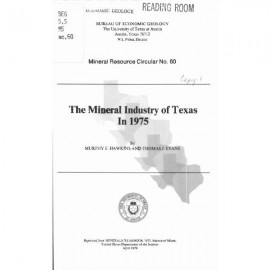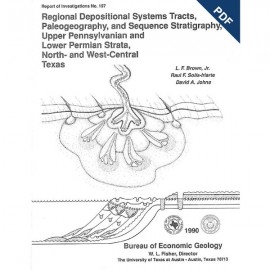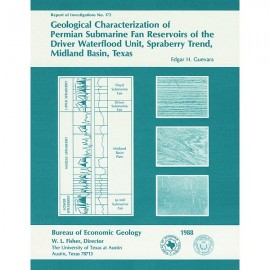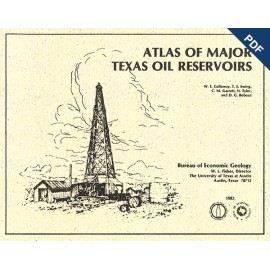Reports of Investigations
-
Books & Reports
- Reports of Investigations
- Guidebooks
- Udden Series
- Geological Circulars
- Down To Earth
- Atlases of Major Oil and Gas Reservoirs
- Texas Memorial Museum Publications
- Environmental Geologic Atlas of the Texas Coastal Zone
- Mineral Resource Circulars
- Other Reports
- Seminars and Workshops
- Handbooks
- Submerged Lands of Texas
- Symposia
- Annual Reports
- Open File Reports
-
Maps & Cross Sections
- Thematic Maps
- Miscellaneous Maps, Charts & Sections
- Geologic Atlas of Texas
- STATEMAP Project Maps
- Geologic Quadrangle Maps
- Cross Sections
- Highway Geology Map
- Energy and Mineral Resource Maps
- Shoreline Change and Other Posters
- Wilcox Group, East Texas, Geological / Hydrological Folios
- Bouguer Gravity Atlas of Texas
- River Basin Regional Studies
- Featured Maps
- Posters
- Teachers & the Public
-
Geological Society Publications
- Gulf Coast Association of Geological Societies
- Alabama Geological Society
- Austin Geological Society
- Corpus Christi Geological Society
- Houston Geological Society
- Lafayette Geological Society
- Mississippi Geological Society
- New Orleans Geological Society
- South Texas Geological Society
- GCS SEPM Publications
- Historic BEG & UT Series
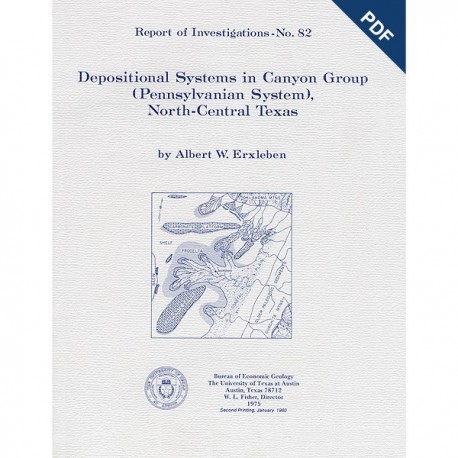
Depositional Systems in Canyon Group (Pennsylvanian. System), North-Central Texas. Digital Download
RI0082D
A free, digital version of this publication can be found on: Texas ScholarWorks
To purchase a print version (if available): RI0082
RI0082D. Depositional Systems in the Canyon Group (Pennsylvanian System), North-Central Texas, by A. W. Erxleben. 76 p., 33 figs., 9 plates, 3 appendices, 1975. doi.org/10.23867?RI0082D. Downloadable PDF
To purchase this publication in book format, please order RI0082.
ABSTRACT
The Canyon Group (Missourian Series) is a sequence of westward-dipping, genetically related carbonate and terrigenous clastic facies that crop out in a northeast-southwest belt across North-Central Texas. The section includes stratigraphic units between the base of the Palo Pinto Limestone and the top of the Home Creek Limestone.
Surface and subsurface studies within thirteen counties indicate that the terrigenous clastic rocks are principally component facies of high-constructive delta systems. The Perrin delta system repeatedly prograded westward and northwestward from source areas in the Ouachita foldbelt. Algal-crinoid banks flanked the Perrin delta system on the northeast and southwest. A typical vertical deltaic sequence includes (upward) (a) organic-rich prodelta mudstone, devoid of invertebrate fossils; (b) thin, distal delta-front sandstone and mudstone, displaying graded beds, sole marks, and flow rolls; (c) thicker proximal delta-front sandstone, exhibiting contorted beds, flow rolls, and contemporaneous faults; (d) locally contorted distributary-mouth bar sandstone; and (e) distributary channel sandstone, containing abundant trough cross-stratification and local clay-chip conglomerate. Thin, coal-bearing delta-plain deposits occur locally on top of deltaic sequences. All delta facies are rich in plant debris.
During delta abandonment and destruction, shallow bay-lagoon environments developed. Destructional facies include bioturbated sandy mudstone, burrowed sandstone, and thin, platy argillaceous limestone with abundant invertebrate fossils. Fossiliferous mudstone facies grade upward into transgressive shelf-carbonate facies commonly composed of phylloid algal-crinoid biomicrudite and local intraclastic biosparite shoal facies. Shelf carbonates include onlapping sheetlike deposits, thick, elongate bank deposits which stood above the sea floor with slight bathymetric relief, massive platform carbonate, and shelf-edge reef-bank accumulations.
The Henrietta fan-delta system, occurring exclusively in the subsurface of Montague, Clay, Wichita, Archer, and Baylor Counties, is composed of thick wedges of feldspathic sandstone and conglomerate that were deposited by high-gradient fluvial systems which built southwestward into northern Texas from source areas in the Wichita-Arbuckle Mountains of southern Oklahoma.
Keywords: Archer County, Baylor County, Clay County, Canyon Group, depositional systems, Home Creek Limestone, Palo Pinto Limestone, Perrin delta system, Missourian, North-Central Texas, Pennsylvanian, subsurface, Texas
Citation
Erxleben, A. W., 1975, Depositional Systems in the Canyon Group (Pennsylvanian System), North-Central Texas: The University of Texas at Austin, Bureau of Economic Geology, Report of Investigations No. 82, 76 p.

